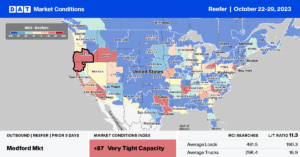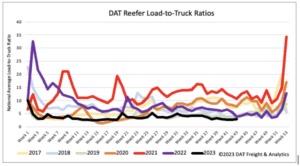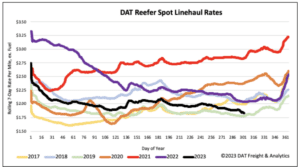Remember to be thankful for Minnesota, the so-called “Land of 10,000 Lakes”, when you sit down to Thanksgiving dinner this year. Minnesota is the number-one state for turkey production by a wide margin. So it’s no big surprise that the Minneapolis market area will also be the land of 1,000 loads per day this Thanksgiving as fresh turkeys are stuffed into reefers.
According to the September 2023 Turkey Raised report from the USDA, the number of turkeys raised in the United States increased to 219 million this month, up 4% from the number raised in 2022. Minnesota’s produced 39 million turkeys in 2023, up 5% from the previous year. North Carolina produced 29 million turkeys, up 4%, while Arkansas produced 27.5 million turkeys, up 4% from 2022.
Domestically, turkey production is scattered, with 174 plants in 20 states. The following five states account for 58% of production:
- Minnesota
- North Carolina
- Arkansas
- Indiana
- Missouri
USDA data shows these top five states produce around 135 million live turkeys at an average live weight of 33 pounds – or 96,000 reefer truckloads. Most production plants are located within 100 miles of farms. Because of the regional location of farms and processing plants close to feeding sources, the outbound truckload freight task typically involves a much longer length of haul, given the distance to distribution centers close to major consumer markets in North America. According to the National Turkey Federation, the U.S. exports around 10% of production annually, with just over 80% of that amount going to Mexico.
Market Watch
All rates cited below exclude fuel surcharges unless otherwise noted.
At $2.07/mile last week, outbound reefer linehaul rates in the Pacific Northwest (PNW) states, including Washington, Oregon, and Idaho, were up $0.02/mile and $0.08/mile y/y. Outbound reefer rates averaged $2.05/mile in Spokane, while in the larger Twin Falls market, rates averaged $2.30/mile. Loads to Los Angeles and Fresno averaged $2.06/mile and $2.00/mile respectively.
In Arizona, reefer linehaul rates increased by $0.06/mile to $1.71/mile last week, signaling the start of the produce season in the southwestern part of the state. This time last year, spot rates in Phoenix were around $1.84/mile but increased seasonally by just over $0.60/mile by the end of 2022.

Load to Truck Ratio (LTR)
After remaining flat for the prior two weeks, last week’s volume of Reefer load posts (LP) decreased by 3% w/w and 41% y/y. Carrier equipment posts (EP) were down 7% w/w, resulting in last week’s reefer load-to-truck ratio (LTR) increasing by 4% to 2.90, the lowest reefer LTR in seven years.

Spot Rates
Spot rates decreased last week by $0.02/mile to $1.87/mile. Reefer linehaul spot market rates are $0.21/mile lower than last year. Even though PNW Fall produce regions (~15% of volume) are producing higher volumes this year, 18% lower y/y volume in the largest California produce market (~25% of volume) is impacting national truckload volumes. Compared to this time last year, when there were only two of 16 produce-growing regions reporting a surplus of trucks, the USDA reported nine regions having a surplus of trucks last week.



